Unit Fraction – Introduction
In mathematics, fractions represent a part of a whole thing, region, or collection. In other words, a fraction is a numerical value that depicts a portion or section of an entire quantity that can be a number, a certain value, or a thing.
Every fraction includes a numerator and a denominator, separated by a horizontal line called the fractional bar.
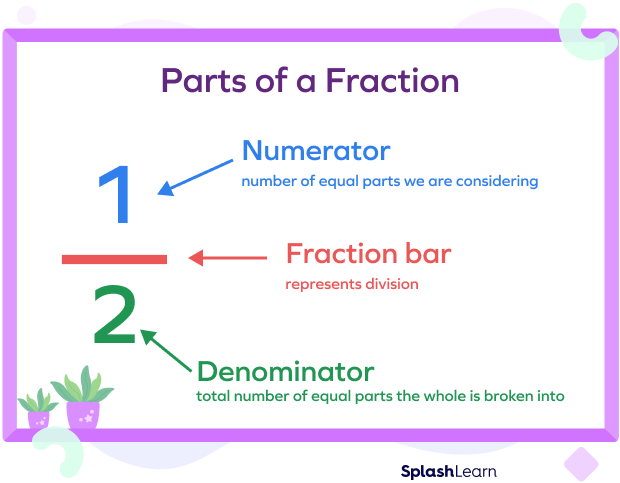
Based on the value of the numerator and denominator, fractions are categorized under several types, like an improper fraction, proper fraction, unit fraction, etc.
Recommended Games
What Is a Unit Fraction?
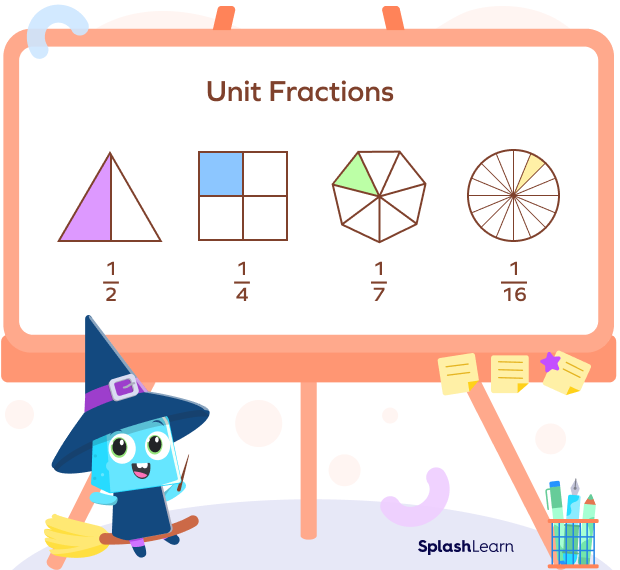
In math, a unit fraction can be defined as a fraction whose numerator is 1. It represents 1 shaded part of all the equal parts of the whole. The term “unit” means one.
For instance, if a pizza is divided into 4 equal portions and one person is eating one portion of it, it can be numerically represented as 1/4.

If a whole is divided into three equal parts, each part is represented by the fraction 1/3, written as one-third of the whole.
Similarly, if a whole is divided into four or five equal parts, each part is represented by the fraction 1/4 or 1/5, written as one-fourth or one-fifth of the whole.
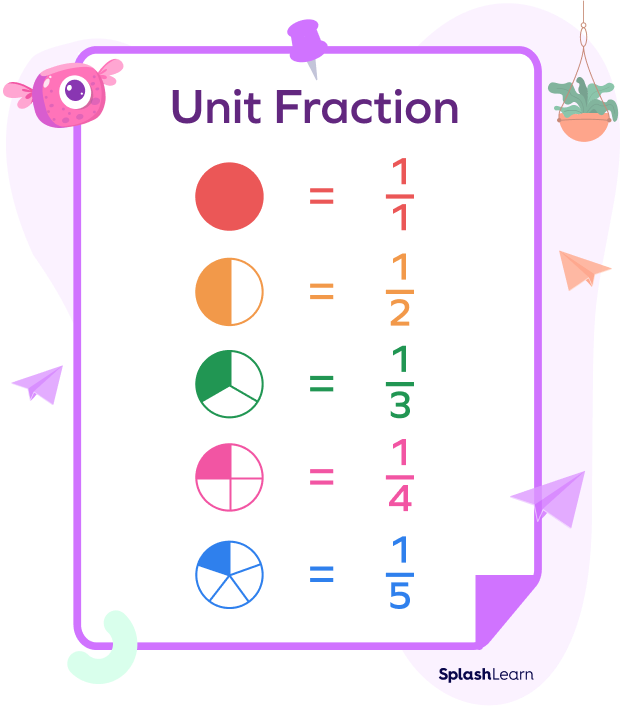
Recommended Worksheets
Difference Between Unit and Non-unit Fraction
While a unit means one, a non-unit represents any number other than one. Hence, a non-unit fraction is a fraction with a numerator other than one. The denominator can be any whole number except 0. Examples: 2/3, 3/5, 4/7, etc.
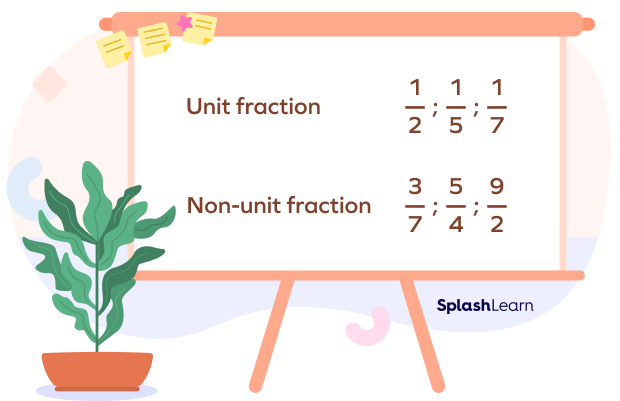
How to Multiply Unit Fractions
A unit fraction can be multiplied with other unit fractions, non-unit fractions, or a whole number.
Multiplying Unit Fractions with Unit Fractions
We simply multiply the numerator with the numerator and the denominator with the denominator.
For example, let’s multiply $\frac{1}{3}$ and $\frac{1}{4}$.
$\frac{1}{3} \times \frac{1}{4} = \frac{1 \times 1}{3 \times 4} =\frac{1}{12}$
Multiplying Unit Fractions with Non-unit Fractions
We simply multiply the numerator with the numerator and the denominator with the denominator. We simplify the result only if necessary.
For example, let’s multiply $\frac{1}{2}$ and $\frac{3}{5}$.
$\frac{1}{2} \times \frac{3}{5} = \frac{1 \times 3}{2 \times 5} = \frac{3}{10}$
How to Add Unit Fractions
Let’s understand how to add unit fractions with
i) same denominators
ii) different denominators
With the Same Denominators
Here, we only add the numerators and place the resulting sum over the common denominator. Then, we simplify our results if necessary.
For example: Let’s add $\frac{1}{4}$ and $\frac{1}{4}$.
$\frac{1}{4} + \frac{1}{4}$
$= \frac{1 + 1}{4}$
$= \frac{2}{4}$
$= \frac{1}{2}$
With Different Denominators
Let’s say we need to add $\frac{1}{4}$ and $\frac{1}{5}$. Here’s how to do it:
Step 1: Identify the least common multiple of the denominators.
Identify the least common denominator (LCD) of the given fractions.
For that, we list the multiples of each denominator until we find the first common one.
Multiples of 4 = 4, 8, 12, 16, 20, 24 . . .
Multiples of 5 = 5, 10, 15, 20 . . .
So, the least common multiple here is 20.
Step 2: Convert each fraction to an equivalent fraction with the least common multiple as the denominator.
Here, the LCM is 20.
To convert $\frac{1}{4}$ to a denominator with 20, we will have to multiply the fraction by $\frac{5}{5}$.
$\frac{1}{4} \times \frac{5}{5} = \frac{5}{20}$
To convert $\frac{1}{5}$ to a denominator with 20, we will have to multiply the fraction by \frac{4}{4}$.
$\frac{1}{5} \times \frac{4}{4} = \frac{4}{20}$
Step 3: Add the fraction using the equivalent fractions and simplify.
Now, the denominator of both the fractions is the same. So, we add the numerators of the like fractions and place the resulting sum over the common denominator.
$\frac{1}{4} + \frac{1}{5}$
$= \frac{5}{20} + \frac{4}{20}$
$= \frac{5 + 4}{20}$
$= \frac{9}{20}$
How to Subtract Unit Fractions
The process of subtraction is similar to the addition, but instead of adding the numerators in step 3, we subtract them here and simplify the answer.
For example, let’s subtract $\frac{1}{5}$ from $\frac{1}{4}$.
Step 1: Identify the LCM
Multiples of 4 = 4, 8, 12, 16, 20, 24 . . .
Multiples of 5 = 5, 10, 15, 20 . . .
So, the LCM here is 20.
Step 2: Convert each fraction to a fraction with the least common denominator.
$\frac{1}{4} = \frac{1}{4} \times \frac{5}{5} = \frac{5}{20}$
$\frac{1}{5} = \frac{1}{5} \times \frac{4}{4} = \frac{4}{20}$
Step 3: Subtract the fractions and simplify.
$\frac{1}{4}$ $–$ $\frac{1}{5}$
$= \frac{5}{20}$ $–$ $\frac{4}{20}$
$= \frac{5 – 4}{20}$
$= \frac{1}{20}$
Solved Examples on Unit Fraction
Example 1: Find the sum of $\frac{1}{3}$ and $\frac{1}{7}$.
Solution:
Step 1: Identify the least common multiple of the denominators.
Multiples of 3: 3, 6, 9, 12, 15, 18, 21, 24
Multiples of 7: 7, 14, 21
So, the LCM is 21.
Step 2: Convert each fraction to an equivalent fraction with the least common multiple as the denominator.
Now, we convert the fractions into a denominator with the LCM.
$\frac{1}{3} = \frac{1}{3} \times \frac{7}{7} = \frac{7}{21}$
$\frac{1}{7} = \frac{1}{7} \times \frac{3}{3} = \frac{3}{21}$
So,
$\frac{1}{3} + \frac{1}{7}$
$= \frac{7}{21} + \frac{3}{21}$
$= \frac{7 + 3}{21}$
$= \frac{10}{21}$
Example 2. Subtract $\frac{1}{8}$ from $\frac{1}{6}$.
Solution:
Multiples of 8: 8, 16, 24, 32
Multiples of 6: 6, 12, 18, 24,
So, the LCM is 24.
Now, we convert the fractions into a denominator with the LCM.
$\frac{1}{8} = \frac{1}{8} \times \frac{3}{3} = \frac{3}{24}$
$\frac{1}{6} = \frac{1}{6} \times \frac{4}{4} = \frac{4}{24}$
So,
$\frac{1}{6}$ $–$ $\frac{1}{8}$
$= \frac{4}{24}$ $–$ $\frac{3}{24}$
$= \frac{4–3}{24}$
$= \frac{1}{24}$
Practice Problems on Unit Fraction
Unit Fraction
What is the fraction represented by the shaded part of the given model?
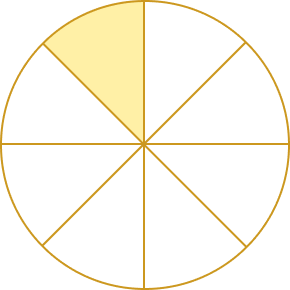
The figure is divided into 8 equal parts, out of which one part is shaded. Hence, it can be represented as $\frac{1}{8}$.
Find the sum of the fractions 1/7 and 1/7.
$\frac{1}{7}$
$=\frac{1 + 1}{7}$
$=\frac{2}{7}$
What is the product of the fractions $\frac{1}{5}$ and $\frac{1}{7}$?
$\frac{1}{5} \times \frac{1}{7} = \frac{1 \times 1}{5 \times 7} = \frac{1}{35}$
Frequently Asked Questions on Unit Fraction
What is a unit fraction?
Unit means one; hence, a unit fraction is one part of a whole number. Here, the numerator is always 1, and the denominator can be any whole number.
Can 1 be a unit fraction?
Yes. 1 is a unit fraction because, as a fraction, it can be represented in the form of 1/1.
How can we identify which unit fraction is larger?
The unit fraction with the larger denominator is smaller, and the one with the smaller denominator is larger. For instance, $\frac{1}{5} \gt \frac{1}{7}$ .




































